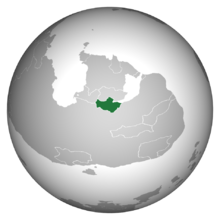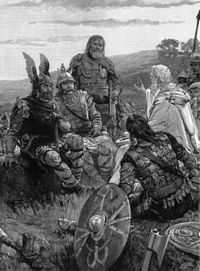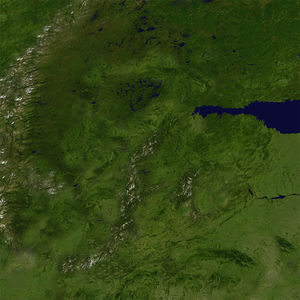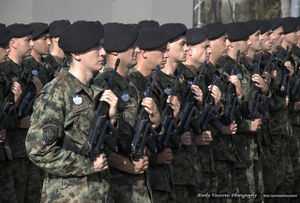Nation/Weremark
| Kingdom of Weremark Kuningsgard Wærmark
|
||||||
|---|---|---|---|---|---|---|
|
||||||
| Motto: "Andaláus Ihre, Magnem Liuda." "Endless Honor, Great Prosperity." |
||||||
| Anthem: "Palestinelied." | ||||||
Weremark's location on Mundus.
|
||||||
| Capital and largest city | Hailia | |||||
| Official languages | Werman | |||||
| Recognised regional languages | Low Werman, Altbergish, Norse | |||||
| Ethnic groups (2009) | Werman (95.65%), Heimarn (4.26%), Vand (0.09%) | |||||
| Demonym | Werman | |||||
| Government | Feudal Kingdom | |||||
| - | King | Dagmund Altberg | ||||
| - | Duke of Altberg | Magnus Altberg | ||||
| - | Duke of Jylmark | Johannes Jensen fan Hailien | ||||
| Legislature | House of Lords and Ladies | |||||
| Independence | ||||||
| - | Consolidation of Weremark | 1041 CE | ||||
| - | Werman War of Succession | 1337 CE | ||||
| - | Ratification of the Kuningsjesazen | 1398 CE | ||||
| Area | ||||||
| - | Total | 546,059 km2 210,835 sq mi |
||||
| - | Water (%) | 17% | ||||
| Population | ||||||
| - | 2017 estimate | 17 million | ||||
| - | Density | 31.13/km2 80.6/sq mi |
||||
| GDP (nominal) | 2017 estimate | |||||
| - | Total | $92.212 billion | ||||
| - | Per capita | $5424.23 | ||||
| Gini (2017) | 47.1 high |
|||||
| HDI (2017) | 0.704 medium |
|||||
| Currency | Eagle (WME) |
|||||
| Time zone | Eastern Standard Time (EST) | |||||
| Date format | DD/MM/YYYY | |||||
| Calling code | +82 | |||||
| Internet TLD | .wm | |||||
The Kingdom of Weremark (pronounced /wɛrmark/) or Wærmark in Werman is a developing federal monarchy of approximately 17 million inhabitants in mid-northern Cotf Aranye. The nation of Vandinium lies to the west and southwest, respectively. It is bordered to the north by Aurora, and to the immediate west by Heimar, with which it shares the Kørpergroße mountain range.
Originally a conglomeration of Germanic tribes collectively referred to as the Weres, the Kingdom of Weremark was consolidated by Otto Altberg in 1041, after which feudal traditions gradually entrenched themselves in the nation's sociopolitical sphere. The Kingdom expanded throughout the first millennium, resulting in various tributary states and vassals, including Wahland. It is governed as an absolute monarchy with varying degrees of vassal control and popular input. It is considered to be a highly decentralized state, with infrastructure, economics, and energy often relegated to the sole responsibility of regional vassals. There are over 150 bannermen sworn to the King of Weremark, among them Dukes, Counts, Margraves, and Jarls, however, many modern and merchant republics defer to the Werman crown as well. Weremark holds a strong aristocratic tradition and is noted for its enduring sense of chivalry, a fact marking it as one of the few clear-cut "monarchist" states remaining in the modern world. Culturally, it shares links to neighbors Heimar and Vandinium, as well as Aurora.
Weremark holds considerable natural and energy resources but has neglected to access them since the onset of the 21st century, for various geopolitical reasons. Weremark has come to be known for its furniture, automobile, and defence industries. Weremark has been recognized as both a great power and a regional power since its civil war, however, the nation was characterized as a superpower for a large portion of the early 1990s and 2000s. Weremark is part of the Nevthronian Defense Pact,
Etymology
The etymology of the word Weremark is a subject which occasionally attracts debate. Most sources derive the first part of the word, and by extension the name of the people, from the general Germanic root for "man", related to English Werewolf. The -mark is believed to mean borderland, with probable references to the southern border with Vandinium.
The first recorded use of the word Weremark within Weremark itself is found on the baptismal Writ of Weremark, which declared Weremark's official existence in 1041 CE. The word is written in the form of nominative ᚹᛖᚱᛖᛗᚨᚱᚲ, a form still used today. The inhabitants of Weremark are there called "Wæren" ([wɛren]), or "Weres", in the accusative.
History
Prehistory
Weremark's history begins at the southwestern base of the Kørpergroße mountains, located along Weremark's modern borders with Heimar and Artstotszka.This period was characterised by small bands of hunter-gatherer-fishers using flint technology. Agriculture developed independently around 11,500 BCE, with Germanic tribes in the area consolidating and forming economies based on the cultivation of wheat and potatoes.
Germanic tribes living in what was to become Weremark are first mentioned by EXTERNAL HISTORIAN in 120 BCE. In CLASSICAL WORK OF HISTORY, he mentions the Goths (Goteas) as a powerful tribe specializing in bronze mining, and the Jylls (Jillanis) as great warriors and sailors. Though the exact history of these early tribes is not exactly known, Germanic mythology mentions several mythical and semi-mythical kings as having ruled both tribes at the time. As for literacy in Weremark, evidence of a Proto-Runic system exists from as far back as 300 BCE. Artifacts recovered from Oltbjorgvilke reveal that, when transliterated correctly, the Proto-Werman language was much more mutually-intelligible with modern Werman compared to other languages of the time.
Around 49 CE, EXTERNAL HISTORIAN #2 describes the Goteans and Jyllans as being of the same stock and the tallest of people. He also mentions various Germanic tribes as having gained in the territory, including the fledgeling Vareans. The Vareans return in later histories of the era, noted for their strong and organized society and iron metalworking.
Feudal Age and Reformation
Sudrogothic historian Schaonric mentions around 321 CE that the Varans had begun a conquest of neighbouring Germanic tribes, but had been repelled by the hosts of Redoric Theordicing and Jarkin fan Nikberg, of Hailia and Jylmark, respectively. External sources at the time falsely describe the whole region as having belonged to the Varans, and, in the next centuries, the whole region and its peoples came to gradually be referred to as belonging to the 'Weres', a phenomenon accelerated by the near-identical languages of the Varans and Jylls, and the shared Germanic religion of all the tribes.
By 940 CE, the Varans had successfully annexed the lands of the Jylls, and created the first legitimate governmental structure in Weremark, the Grand Duchy of Jylmark. In 1041 CE, Jylmen under the command of Otto Altberg, 'The Werewolf', successfully conquered the Gothic lands of Sigisland and Stiurberg, enabling the creation of the modern title of King of Weremark, and stabilizing the region under one ruler for the first time in recorded history. The Grand Duchy of Jylmark passed onto cadet branches of the Altberg family, while those who had submitted peacefully were allowed to keep their lands and titles as vassals to the crown. In Weremark subsequently developed Feudalism in a modified form, known as Lahnschaft. Lahnschaft Feudalism excludes the clergy from owning land, instead granting the First Estate to merchants and the middle class.
While thralldom had been common in Weremark, indentured servitude developed as the basis for hard labour, supplanting serfdom and thralldom. Eventually, both slavery and serfdom were abolished altogether by a decree of King Magnus Beartooth in 1244. Former thralls and serfs tended to be absorbed into the peasantry, and some became labourers in the towns. However, aside from the important port city of Hailia, Weremark remained a largely backwards country, with most rural communities operating on barter-based systems until the consolidation of the Banking Orders in 1299. In the early 1300s, Weremark expanded north into Aurora, conquering Vipura and Blackhorn from the local Kitari cultures.
In 1337, King Rikard Altberg of Weremark died prematurely, leaving his teenage daughter Jorva in command of Weremark. Rikard's bastard, Athalaric the Hawk, recently returned from Aurora, raised questions about Jorva's illegitimacy, given Rikard's record of adultery and his own birth. Athalaric argued unsuccessfully before Weremark's vassals that he should be the rightful ruler of Weremark, as he had tangible proof that he had been born within Weremark's castle walls to a noblewoman, while Jorva had no such guarantee. After being sternly rejected by Gunther Horenhelm, Grand Duke of Jylmark and Designated Regent, he declared open rebellion against Jorva's supporters in the Werman War of Succession, securing a victory in 1339 and legitimizing himself as King Athalaric Altberg. Today considered a national hero, King Athalaric is now best remembered for establishing the modern basis of the Werman status quo: the Kuningsjesazen (Kingslaws).
Expansion and Renaissance (1400–1621)
After Athalaric Altberg's death, the realm passed to his firstborn son, Alfarin, but his premature death in a tavern brawl led to the realm passing to Athalaric's thirdborn, Heinrich, after his daughter Ava had refused the throne. Heinrich's line was marked with the arrival of the sociocultural Renaissance, and the reinvigoration of foreign trade. By 1485, Weremark had a sizable avenue of trade through the Gulf of Hailien, and had established relations with many nations on Cotf Arayne. As the largest cities, including Hailia and Altberg, began to suffer from overpopulation, many left, either as missionaries or as adventurers. A particular target was neighbouring Vandinium, an already destabilized husk of its former self. In the 15th and 16th centuries, Vandinium's borders were subject to considerable emigration from Weremark, and several Werman border vassals took it into their own initiative to conquer large stretches of Vandiniumite land occupied by a mostly decentralized society of city states and villages.
Weremark is notable for its independent discovery of a new form of steelworking during this time. Tjornbolt Steel, made with naturally occurring Osmium and Vanadium, proved especially resilient, and served as a large revenue stream for Weremark abroad. Foreign crops, such as potatoes and rice, likely prevented a major famine in the late 15th century. Despite the influx of trade, Royal Decree led to Werman craftsmen beginning a concerted effort to remain self-reliant around this time, a fact which led to many independent discoveries, including gunpowder and the matchlock musket in 1564.
Early Modern History (1621–1849)
In 1621, Weremark faced its first serious external obstacle when Lydia the Steadfast of Aurora invaded Vipura with the objective of reclaiming lands lost three hundred years earlier. The High Lord of Vipura, Wilhelm Blausteining, immediately called for Royal help, thus beginning the Four Years' War. Primarily fought in Vipura and at sea, the war saw the first large-scale use of gunpowder weaponry in Werman history. By 1623, the war had swung largely into Auroran favour, due to internal strife and a serious plague in central Weremark at the time. Out of options, King Athalaric II manoeuvred the main Werman host away from the capital and marched to Vipura to personally speak with Lydia. After a heated discourse, Lydia left the rest of Weremark in peace, but the High Lordship of Vipura entered into Auroran hands. The conflict reignited tensions between the two nations that would last for centuries, and Athalaric II departed the realm in dishonour, abdicating the throne to his son.
The following century would see the establishment of two of the most important educational institutions in Weremark: The University of Altberg in 1644, and The University of Jylmark in 1684, both of which served as a merger of earlier vocational and clerical schools. The presence of these institutions led to a liberalization of the nobility, and for a brief period, many nobles married the daughters and sons of prominent merchants, as opposed to their fellow mobility. Set on expanding Weremark's influence and ensuring its insulation from outside forces, King Adolphus Altberg, grandson of Athalaric II, ordered expeditions abroad, which led to Weremark's discovery of promising lands in Wahland in 1710, which was subsequently colonized by plethora of lesser Nobles and various merchant families searching for gold.
To the west, Weremark began competing with the Heimarn crown for political influence over smaller Germanic duchies, which had for centuries served as a buffer zone between the two powers. Though slow to build, these tensions ignited after Heimar formally annexed several bordering duchies, including the most prominent Duchy of Jagerfeld. Taking it as a provocation, King Athalaric III, barely a teenager, declared war on Heimar in 1794, suffering defeat after defeat in the subsequent War of The Blackbirds. The pivotal Battle of Neauarnsberg led to a pyrrhic Heimarn victory, and by virtue of honour, Athalaric was advised to sue for peace. The war left many Wermans and Heimarn displaced, and led to Weremark's loss of Wahland and several border territories, while also ensuring Heimar's continued independence. At the onset of the 19th century, Weremark was at its smallest extent yet.
Tensions regarding the result of the War of The Blackbirds, as well as a stark geopolitical shift in the world's system of government, led to massive unrest in the early 19th century, with advocates for democracy or constitutional monarchy increasingly vocal. Aiming to distract, King Athalaric invaded the newly-independent Wahland, aiming to save face and regain lost territory. Despite promising gains in the first month of the conflict, the Wahlsh navy crushed what remained of the Werman Navy in the Battle of The Strait. After large riots in Hailia nearly breached the Altberg Keep's walls, Werman troops withdrew from Wahland in 1810 to help police the capital. Soon after, the riots were quelled by the Royal Decree of 1811, which granted the merchant class more power and promised the construction of more schools for the poor. The decree, along with the expansion of various city guards at the time, likely quelled a potential revolution. 19th May, the day the Royal Decree was officially signed, is now the national Labour Day.
Industrial Revolution
The first industrial mill was commissioned by Theoric Narheim, Grand Duke of Jylmark, in 1849, after two decades of slow advancement. The mill marked the first of many mechanized ventures in Weremark, with an additional sixteen springing up throughout the realm in the following five years. The force of industry returned much-needed trade revenue to Werman shores, as it had been earlier lost to Wahland's powerful mercantilistic power. While most systems throughout the world began to transition to capitalism, Werman feudalism persisted unhindered, with a string of royal decrees anticipating the later need for worker's rights, and therefore foregoing the unrest witnessed elsewhere in the world by the end of the century. Nevertheless, several important corporations still emerged from the merchant class, including Ostrofracthandal and Winter Armory. The arrival of foreign investment enabled the merchant class to balloon in wealth, with some eclipsing the nobility in net worth.
In 1889, noting his vassals' unwillingness to implement modern infrastructure, including infrastructure and railroads, King Rikard II overrode his vassals, starting a major works program throughout their lands, in exchange for being unable to levy direct taxes on the nobility for the duration of construction. The venture nearly bankrupted the personal coffers of the Altberg family, but managed to bring modern infrastructure to Weremark, and the support of the peasantry back to the crown, at least partially.
Feudal authority suffered a serious setback in 1905, when Rikard II died to an assassin's bullet, and the leading business moguls of the First Estate claimed full responsibility, declaring their intention to turn Weremark into a democratic system. The upheaval proved that the concessions of a century earlier were not only temporary, but also ineffective. Liudger Altberg, the new King, elected instead to cement the power of the nobility, declaring a series of heavy taxes designed to cripple the merchant class. Though considered unlikely to work by most economists of the time, the tax was successful, and had the unexpected side-effect of further increasing the popularity of the status quo among the peasantry, who had been reeling from unchecked corporate business practice throughout the Gilded Age.
Geopolitical Relevance
In 1968, tensions with Weremark's rival Aurora reignited over the disputed land of Korlun when a group of Men-at-Arms under the authority of the Grand Duke of Jylmark on the island opened fire on Auroran foot soldiers, leading to a chemical accident and the destruction of a dam. Initially, the crown denied the soldiers' involvement, but after their presence was proven, they instead took a defensive stance. Both nations began a military buildup in preparation for conflict. Nearby Vandinium took note of the military buildup and followed suit, fearing for a potential flashpoint in the region.
In 1971, Vandinium, then helmed by Emperor Treven Von Stein formally declared war on Weremark after the Vandiniumite Senate reached consensus regarding a 'preemptive' War of Conquest. The First Nevthronian War formally began on 9 April 1973, in a surprise attack. As surprise strikes are largely considered to be dishonourable in Werman culture, the event is often referred to as the Blackguardly War, especially in Southern Weremark. Though the war quickly devolved into a stalemate near Weremark's southern border, it is perhaps best remembered as having popularized many figures in pop culture and politics, including Johannes Jensen fan Hailien and TV personality Hinrich Reinhart. During the war, the Altberg Disaster occurred when a stray cluster bomb launched by Wereman aircraft struck the Altberg North Nuclear Power Plant, inducing a meltdown that displaced 1.21 million people, including the King of Altberg, and resulted in the capital moving to Hailia. The subsequent economic depression Weremark has yet to recover from.
Weremark's successful defence of their borders led to sporadic border conflicts with Vandinium forces for the next two decades, culminating in the Second Nevthronian War in 1991 and Wereman interventions in Vandiniumite Civil Wars, in 1995 and 2012. The latter intervention proved particularly disastrous when the Karthspire Incident resulted in the deaths of several members of the Wereman military nobility, and a largely successful invasion of southern Weremark by Vandiniumite forces then under the control of the Blackwatch Regime. The event called into question the political legitimacy of the House of Altberg, and prompted several western Lords under the command of Karl Narheim, Grand Duke of Jylmark, to rebel against the Werman status quo, thus beginning the Werman Civil War. Existing political movements in the east materialized into the anarcho-socialist National Freedom Assembly and fascist National Socialist Werman Worker's Party, both of which mobilized sizable militia forces against the royalist factions. Though the NFA were initially able to secure the support of Heimar, the Royalist victory against Vandiniumite invaders in the south, and new Heimarn leadership in Markus Albrecht led to Heimarn forces joining the royalist faction and helping to reunite Weremark under the status quo.
Geography
Though greatly diminished from its earlier size, Weremark still occupies over 546,059 square kilometers (210,835 sqmi). Situated in northern Cotf Arayne and bordering the Gulf of Weremark, the majority of the nation possesses a largely boreal climate.
A small lowland on the Gulf seaboard gives way further inland to deciduous forests and the rolling hills of southeastern Weremark, which encompasses primarily the Duchy of Oltbjorgvilke. Within this area of Weremark begin rolling hills that eventually level out once more as they near the easternmost border of Weremark. Also in southeastern Weremark are the craggy yet tall Hlymrek Alps, which form the border between Keilland and Kartspir.
Close to the capital of Hailia begin the second-longest range in Weremark, the Baraberg Mountains, of which many major cities are a part, including New Altberg, Volunsberg, and Arheimar. The northernmost sections of the mountain range constitute the Altberg Exclusion Zone, created after the Altberg Incident left the old city largely uninhabitable. The Baraburg mountains serve as a geographical crossroads in Weremark, forming the borders for several vassal states and separating South Weremark from Jylmark. The Baraburg mountains, though a tributary range of the Körpergroße themselves, also contribute several tributary ranges of their own, including the Wustern, Adin, and Korin ranges.
Northern Weremark consists mostly of low marshland with only a few scattered formations of hills. In the Republic of Verica exists Weremark's lowest point, the Great Gorge, at -24 meters below sea level. The immediate border with Aurora forms the low Arnsbarg mountains, though Weremark's official territory extends somewhat beyond their extent.
Eastern Weremark consists primarily of lands encompassing the Grand Duchy of Jylmark, which consists mostly of low fields and serves as a prime agricultural region for Weremark, along with Neuarnsbarg. Western Jylmark, however, possesses Northern Cotf Aranye's largest mountain range, The Körpergroße mountains, with mountains rising as far as Weremark's highest, Rukof, at 6,930 meters (22,740 ft). Weremark shares the Körpergroße with Aurora and Heimar, and occupies the least land within the Körpergroße zone out of all the nations.
Demographics
The 2009 census listed the population as 21,940,484, while other official estimates have estimated that Weremark's current population has decreased to around 17 million as of January 2015. Estimates in 2017 placed the nominal population growth around 3.9%, a considerable feat after decades of population stagnation. As with all statistics in Weremark, verifiable data will not be available until the 2019 census, largely due to the irregularity of censuses administered by vassals and other local governors. Men and women make up 46.4% and 54.6% of the population, the considerable difference a result of recent conflicts and the displacement of many unlanded single men during the 2003 Civil War. Of the population, it is estimated that roughly 11% belong to the nobility, with 62% belonging to the merchant class, and the remaining 27% belonging to the peasantry, which has been steadily shrinking since the 1850s.
Ethnic Groups
Weremark is a culturally and racially homogenous country, with 94% of the nation belonging to the Werman culture, which has direct historical links to various ancient peoples, including the Goths, Jylls, Aurorans, Heimarn, and various other Germanic offshoot groups. Despite its historically lax policies towards foreign immigration, Weremark saw more Weres leaving than others arriving. Those that arrived primarily include Heimarn and Kitari, as well as Vaimerian Saxons. Genetic studies funded by the University of Altberg have recently pinned Weremark as one of the most genetically homogenous nations on the planet, with almost 14% of those surveyed having close genetic similarity as early as two generations back.
The primary language of Weremark is Werman, spoken in over one hundred dialects and accents largely based on geography and social class. The 2009 census reported that almost 98% of surveyed Wermans could fluently speak Werman or a mutually-intelligible variant of Werman. The normally taught form of Werman is New High Werman, codified in 1954 as a combination of the dialects of Altbergian and Hailian nobility. About 84% of the non-noble population reported fluency in at least one foreign language, with about 50% of the number going to the English language, spoken worldwide. It is a noble custom in Weremark to learn several languages as part of one's education, including variants of English, French, and German. Despite bilingualism being relatively common, few reported their local school as having had a program in any foreign languages.
Urbanization
Only 39% of Wermans live in urban areas (not including suburbs); the large majority reside in cities with populations over 50,000. In 1999, 25 city titles had populations over 100,000, and ten city titles had more than two hundred thousand. Of those, Weremark's two global cities, Hailia and Jylhaven, had over a million. Though late compared to the rest of the world, Werman populations have gradually begun to consolidate into the cities as the peasantry becomes gradually eclipsed by automated machinery.
| Largest cities of Weremark Data extrapolated by Weremark in regard to TIO population rules | |||||||||
|---|---|---|---|---|---|---|---|---|---|
| Rank | Name | Landed Title | Pop. | ||||||
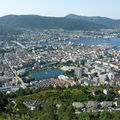 Hailia 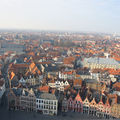 Jylhaven |
1 | Hailia | The Crown Dependency of Altberg and Hailia | 2,240,902 | 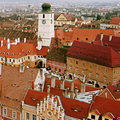 Adinsbaurg  Oltbjorgsheim | ||||
| 2 | Jylhaven | The Grand Duchy of Jylmark | 1,402,921 | ||||||
| 3 | Adinsbaurg | The Republic of Adinsbaurg | 944,242 | ||||||
| 4 | Oltbjorgsheim | The Duchy of Oltbjorgvilke | 792,021 | ||||||
| 5 | Neauarnsbarg | The Duchy of Neauarnsberg | 771,492 | ||||||
| 6 | Skapjan | The County of Skapjan | 744,885 | ||||||
| 7 | New Altberg | The Crown Dependency of Altberg and Hailia | 683,941 | ||||||
| 8 | Kartklikn | The Duchy of Kartspir | 494,640 | ||||||
| 9 | Ostwind | The Grand Duchy of Jylmark | 301,400 | ||||||
| 10 | Scheverin | The County of Scheverin | 278,099 | ||||||
Religion
Germanic paganism is by far the most common religion practised in Weremark. According to the 1999 census, 72.6% of adults identified themselves as Germanic pagans. Wotanism accounted for 86.5%, while Odinism, at 10.1%, was the second most prolific. The irreligious constitute the next largest group, followed by several foreign religions. In the 1999 census, 65% of Wermans said that they underwent religious activities weekly or almost weekly. According to the Kuningsjesazen, the Kingdom of Weremark is to pay tribute the Wotanist pantheon and hold a Great Blót as often as possible to please the gods, yet simultaneously, priests and mystics are overtly prevented from holding land, and the King of Weremark is not indebted to any religious authority. This seemingly contradictory statement, enacted to prevent a total religious takeover, has led to a significant religious faction developing among the nobility and to Wotanism serving as Weremark's de facto official religion. There exist no landed Odinist nobles in Weremark. Foreign religions are tolerated, but the active proselytization of these religions is disallowed.
Over the years, the Wotanist sect of Weremark has liberalized to allow foreigners to join. Unlike in other feudalistic societies, religious authorities never had much power in Weremark, due to the merchant class holding the First Estate. This has led to religion as a whole taking a backseat to Weremark's honour culture and government.
Government
Weremark is a feudal absolute monarchy with elements of democracy on the local level. The government, administration, and organisation of the Kingdom of Weremark were codified in the Kuningsjesazen, written in 1398 at the behest of and with the input of King Athalaric Altberg. The Athalarician improvements on the old proto-feudal mechanisms of governance have been lauded by historians for the increased central control, efficient bureaucracy, accountability, and cultural renaissance they brought into fruition.
Legally, the Monarch of Weremark exercises the conditional right to rule and command over all of his territories. Also, he has supreme jurisdiction in judicial matters, can make legislation, lead the military, and represent Weremark at diplomatic affairs. Due to the nature of the feudalistic system, however, the Kingdom's stability is directly dependent upon the efficiency, loyalty and support of the King's subjects. Underneath the King of Weremark are the high-level vassals, of which there currently are two: The Lord Mayor of Hailia, and the Grand Duke of Jylland. There exist seventeen Dukes or Jarls also sworn directly to the King of Weremark, as well as twenty-two counties and six Republics. Each of these titles, with the exception of the republics, may have additional titles sworn to them. Though succession for the throne of Weremark has functioned with Cognatic Primogeniture since 1994, and this form of succession is most common, vassal lords do not necessarily need to follow this rule. For example, the Grand Duchy of Jylmark operates under Elective Gavelkind.
As with all states operating under Landshaft feudalism, there exists a heavy focus on the ownership of land in Weremark, and voting rights are granted as one moves up the hierarchy, which is as follows:
1. Demesne, the part directly controlled by the lord and used for the benefit of his household and dependents;
2. Dependent holdings carrying the obligation that a merchant household (typically wealthy) supply the lord with specified labour services or a part of their output, subject to the custom attached to the holding. The majority of land in cities not owned by nobles is of the dependent type; This has often been compared to a form of rent in modern times.
3. Free land,or peasant land, on which most of the Third Estate operates. This land is technically under the direct ownership of the liege lord, and dues are paid in the form of taxes and participation in the lord's army. Failure to pay dues or show up for military duty may result in a family's eviction from a plot of land. For the duration of their stay, the peasant family are for all intents and purposes, bound to the Lord's will.
Free men and those in the merchant class which own land are free to participate in local elections, but may not influence high levels of governance. Nobles owning land are by default titular electors, and hold the right to have some of a say in the proceedings of their liege lord. Though some parts of Weremark have allowed nobles to directly vote, others, including the main crown title, follow a more traditional elector system, where more powerful lords hold more power than the lords of smaller titles. Elector lords of the Kingdom of Weremark meet in the House of Lords and Ladies, to discuss matters of state. The House has been located in Hailia since 1975.
As part of reforms in the late 19th century, a system of Feudal referenda was introduced. If a petition to change an aspect of society solely controlled by the nobility reaches 500,000 signatures, the nobility will vote on the issue and reach consensus. King Rikard II envisioned the Feudal referenda system as a form of the peasantry circumventing the merchant class to prevent oppression.
All citizens are afforded the guarantee to be free and speak their mind on most issues. Despite this, a direct insult on the nobility may be punishable by death, depending on the severity and context of the offence.
Military
Weremark's military is known as the Royal Host (Werman: Kynehast). The King of Weremark is commander-in-chief of the Kynehast, though power is delegated by sector army to lords based on geographical location and prominence. During peacetime, the Kyneshast employs around 90,000 in total. The main military branches employ around 78,570: 34,570 in the Royal Army, 26,190 in the Royal Navy, and 17,809 in the Royal Air Force (all including conscripts). The Disaster Relief employs 2,000 (including conscripts), and about 9,430 are employed in non-branch-specific functions such as the Kyneshast Command Group and Werman Military Intelligence. Furthermore, around 55,000 are employed by liege lords as militias or military police; these forces are typically transferred to active national command during wartime, though they are irregularly equipped and trained, serving as vestiges of the levy system.
The Kyneshast in its current form was codified in 2005, following the disastrous management of the levy system during the Werman Civil War. To prevent rogue lords, the military was centralized in a more traditional manner. The military's new direction has garnered some criticism, however, both the public and various vassals have voiced their support of it. The Kyneshast considers itself a warring military, regularly conducting training operations. In its current form, it saw combat in the 2007 Heimar Flashpoint, and against domestic terrorist groups in 2010 and 2012. Though the Kyneshast used to have international force projection capabilities, today, it is a largely regional force owing to its state of drawdown.
Culture
Art, philosophy, and literature
The culture of the people of Wermark is the product civilisations who have influenced its history, including; the Weres, Jylles, Goths, Norsemen, and Heimarn, amongst others. The people of Weremark are immensely proud of their local counties and local culture and it is sometimes suggested they identify more strongly with their region than they do with their country, though this view is likely to decrease with the emphasis on centralization imposed since 2003. Among Weremark's traditions is the Long Sword dance.
Pre-unification Weremark had several notable poets, scholars and ecclesiastics, including Alcuin, Cædmon and Wilfrid. The most esteemed literary family from the county are the three Hali sisters, with Adinsbaurg county being nicknamed Hali Country in their honour. Their novels, written in the mid-19th century, caused a sensation when they were first published, yet were subsequently accepted into the canon of great Werman literature. Bram Vain authored Werewolves of Weremark while living in Jylhold, and it includes several elements of local folklore including the beaching of the Auroran ship Derin, which became the basis of Derener in the book.
Honour culture
Weremark possesses one of the few extant honour cultures on Mundus, quantified in law both in the Kuningsjesazen of 1398 and in earlier individual codes. Honour still plays a major role in general social interactions, especially regarding the concept of trust. Though initially intrinsically linked to one's promiscuity, this view has loosened recently except in the case of high-profile leaders. Women were originally viewed as legally and socially different than men, however, a series of late essays by King Athalaric and subsequent worldwide shifts in gender equality have gradually begun to decrease this perceived difference.
Weremark's honour culture is considered to factor in more into rural areas than urban ones, generally due to the lack of organized law enforcement in those areas prompting direct action by commoners as opposed to organized response. Throughout Weremark, social disputes that would normally prompt lawsuits are expected to be solved at the personal level. Breaches of honour can cause general societal shame, unemployment, or, in extreme cases, deportation. Weremark's honour culture directly caused the Werman Civil War, and as a result, many policies have recently been passed accelerating its legal obsolescence, with honour legally being replaced with modern concepts such as rule of law.
Music
Weremark has a rich history of music and has been both a major exporter and importer of music. Owing to its position at the crossroads of northern Aranye, Werman music has derived considerable influence from Achkaerinese and Auroran music, with such early composers as Urlic Daemon, Gerin fan Schnapp, and Erik Blaue all serving as Weremark's most famous musicians. Since the early 19th century, international music eclipsed that of Werman origin even within Weremark, thus leading to such movements as the Werman Underground and the Werman New Wave throughout the late 20th century. Performers popular internationally around this time included The Nosebleeds, Huskarls, and Fan Kraaft. Folk and traditional music retained its earlier popularity, thus enabling many folk rock and Wotanist groups to form durin the Interwar period, from 1994 to approximately 2002.
Consumer interest in foreign music in Weremark increased dramatically by the dawn of the 21st century, resulting in hundreds of Werman English-speaking bands. Some of these include Blind Guardian and, more recently, Death Ramps. Werman music has recently experienced an international revival owing to the post-2005 peace.
Media
Werman cinema began in 1899 with the production of a documentary about King Rickard I's visit to Jylmark, and a second newsreel incidentally captured his assassination in 1905, which ended up being the first filmed assassination in world history. Regular, live radio broadcasts began in December 1926, largely dealing with news and radio theater shows. The first public TV broadcast in Weremark arrived in July 1960.
Today the Werman media has become a vibrant and competitive sector. There are a plethora of weekly newspapers and magazines, and Wermans have a choice of 23 domestic TV channels and a host of radio stations, though those that discuss subjects considered to be subversive or controversial often arrive from abroad, and it is estimated that an additional twelve stations broadcast in this way. Weremark has only one major news agency. Kuningsgardhails Niuen Nitzwaur (KNN), founded in 1867, is a private regional news agency covering Weremark and its international relations.
Sports
Cuisine
Werman cuisine shares some similarities with other world cuisines such as Alander and Heimarn, but maintains its own unique aspects. Knausupe includes a wide range of sour soups, while schnitzel, freikartoffel, and Kaesen are featured commonly in main courses. Bread is a significant part of Werman cuisine, owing to Weremark's historically strong wheat-culture, and Werman bakeries produce over 3,000 types of bread, pastries, or rolls. Werman cheeses account for about a third of all cheese produced in Aranye, with several varieties popular internationally. In 2012 over 99% of all meat produced in Weremark was either pork, chicken or beef. In 2009, organic foods accounted for 13.9% of total food sales, though this number has decreased due to organic strife. Many in rural regions produce their own food, and there exist several regions where large-scale exploitation of food resources is frowned upon.
Though famous for its rums and brandies, including the most famous wheat-derived Diedic, Weremark is not a major alcohol consumer, instead preferring other drugs, which are unregulated. Werman alcohol was subsidised by the Werman crown until 2005, after which the industry was determined to be strong enough to persist on its own. Beer consumption has increased dramatically since 2009.


